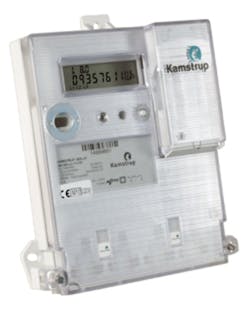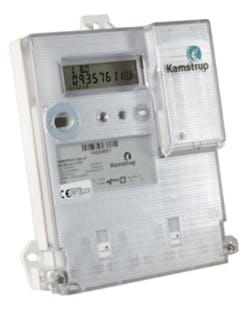Smart Grid Presents Test, Security Challenges
An effective smart grid will require smart meters, and utilities and customers alike will need to be confident that the meters are accurate and tamper-proof. Smart grid initiatives are being determined by the drive for improved energy efficiency as well as utilities’ need to upgrade infrastructure that dates back to the 1900s.
As a National Instruments (NI) newsletter put it, “Since electrification began, many powerful transformations driven by new technologies have occurred. Now technology is coming back to revolutionize the grid itself.”1
Reliability is the problem. The NI newsletter noted that the United States has 300,000 miles of interconnected power lines. The newsletter cited U.S. Department of Energy estimates that imbalances in supply and demand can lead to interruptions that cost $150 billion a year. The newsletter continued, “Smart grid technology will address these issues by automatically predicting and responding to shifting loads, rerouting power around obstructions, introducing distributed storage and renewable generation, and even identifying and locating faults to dispatch repair crews with the appropriate equipment.”
One utility has deployed NI CompactRIO systems as part of its smart grid initiative (see sidebar), but the most obvious sign of the presence of smart grid technology would be a smart meter such as Kamstrup’s 382L direct-connected electricity meter for residential installations.
Kamstrup announced in July that it is joining the eMeter Alliance Program as an Integrated Meter Data Management Technology and Developer Partner. Kamstrup said it would work with eMeter, a Siemens business, to develop and sell integrated solutions for utility smart grid systems. The eMeter integrated Smart Grid ecosystem provides eMeter’s partners with the technology and support necessary to integrate their solutions with eMeter’s EnergyIP meter data management information platform.
Courtesy of Kamstrup
“We have already seen a lot of interest from different markets for a combined eMeter/Kamstrup solution. With the new partnership, utilities will benefit from a standard integration between eMeter’s highly scalable and feature-rich solution and Kamstrup’s high-performing AMI [Advanced Metering Infrastructure]—based on proven, wireless technology and components designed and manufactured in Denmark,” said Henrik Baek Joergensen, senior product manager for smart grid at Kamstrup, in a press release. eMeter and Kamstrup will give each other access to a suite of web services and support including APIs, sample code, demo software licenses, and testing programs.
“Our Smart Grid ecosystem allows utility customers to choose an interoperable solution that integrates the eMeter EnergyIP platform seamlessly with our partners’ technology,” said Shannon Amerman, vice president of technology alliances at eMeter. “This not only will spark mutual success for eMeter and our partners, but it also will lead to reduced costs and improved satisfaction for our customers.”
Smart Meter Security
As smart-grid technologies evolve, utilities and customers will need to have confidence in the security of monitored data. To that end, SecureState, a management consulting firm specializing in information security, announced in July the public release of the full open source code of Termineter, which it describes as “…a framework that allows users to assess the security of Smart Meter utility meters over the optical interface.”
SecureState said the tool brings basic testing capabilities to meter manufactures so they can improve security, and it can help power companies identify and validate internal flaws that leave them vulnerable and susceptible to fraud.
The Termineter framework implements and supports the ANSI C12.18 and ANSI C12.19 standards, offering basic vendor-nonspecific routines so users can interact with and view information on the device using the optical port. It gives users fine-grained control and direct access to the data on the meter.
Present modules allow users to read and write raw data to tables that, in turn, can be used to initiate procedures. Certain modules require passwords to be used. Additional modules support higher level access to certain functionality, such as parsing useful information from the security, modem, and log tables.
Neither Termineter nor the modules contained within it carry any vendor-specific information. The design of Termineter was largely dependent on the ANSI published standards which can be purchased by the general population.
Tamper Detection
Freescale Semiconductor is offering its own approach to security. In June, the company launched a system-level smart-meter reference design that detects physical tampering. The reference design is for a three-phase electricity meter that integrates Freescale’s ultra-low-power Xtrinsic MMA8491Q Tilt Sensor used for electronic tamper detection, a Kinetis K30 Microcontroller (MCU), and an MC1322x RF Transceiver for ZigBee wireless connectivity.
Freescale explained that the Xtrinsic MMA8491Q micro-electromechanical system (MEMS) tilt sensor has X-, Y-, and Z-axis tilt detect outputs with programmable thresholds. When someone tampers with the smart meter, meter movement is detected through the change in tilt angle and then communicated to the utility company. The components also can detect tampering for other smart grid components including data concentrators, intelligent electronic devices (IEDs), and secure gateways.
Freescale’s solution includes the following hardware and software: Xtrinsic MMA8491Q ultra-low-power tilt sensor (400 nA per Hertz); Kinetis K30 MCU with 10 low-power modes (2.1 µA typical for very low leakage at stop mode 1); flexible support of various communications protocols; schematics, gerber files, bills of materials, and source code; and software algorithms for both metrology applications and the MEMS sensor.
Freescale said that replacing a mechanical system with an electronic one results in a more reliable electricity meter that requires fewer field repairs and saves cost.
The smart meter electronic tamper-detection reference design (MK30ETAMP3PHMTR) now is available from Freescale for evaluation.
Manufacturing Test
Of course, smart meters must be tested before they are deployed. Agilent Technologies offers its TS-3000 for use in high-volume manufacturing of smart-meter devices, modules, and subsystems.
An Agilent application note highlights the use of the system to perform tests in six key areas:2
- Power supply, oscillator, and voltage-reference test, and quiescent current measurement.
- Real-time clock (RTC) test, load side voltage monitoring, and relay control test.
- LED test and LCD module display test.
- Optical or serial communications test.
- RF test (for smart meters utilizing wireless communications).
- SDRAM memory test.
The TS-3000 includes a multithreading capability to support the test of up to four DUTs in parallel, minimizing instrument idle time. The system provides dedicated power supplies to test both single-phase and poly-phase DUTs.
References
1. MacCleery, B. and Spexarth, M., “Powering the Smart Grid,” Instrumentation Newsletter, National Instruments, Nov. 12, 2010.
2. Agilent TS-3000—Addressing the Needs of Smart Meter Manufacturing Tests, Agilent Technologies, Application Note, April 2, 2012.
For More Information
Agilent Technologies
eMeter
Freescale
Kamstrup
National Instruments
SecureState
Digitizing the Grid
Smart-grid implementations include generation stations; step-down and step-up substations; and various residential, commercial, and industrial customers, according to Roberto Piacentini, technology program manager, global energy segment, at National Instruments. Dispersed throughout the grid is a variety of sensors.
Speaking as part of a series of webcasts, Piacentini called smart sensors the building blocks for monitoring, controlling, and automating our existing and future transmission and distribution power systems.
He said, “We now have hundreds of devices, multiple protocols, multiple buses, and fixed functionality.” In addition, he said, hundreds of vendors present interoperability challenges. Further, current deployed instruments are unlikely to be networked and digitally controlled and therefore unsuitable for smart grid applications. What’s needed, he said, are a high-performance platform, high-speed data-acquisition systems, high-fidelity ADCs, expandable I/O, and remotely upgradeable software and firmware.
Piacentini recounted how CenterPoint Energy, a Houston-based utility, looked to upgrade its infrastructure, which was designed in the early 1900s. The company needed to meet a rise in domestic electricity consumption while improving demand management and response, integrating green generation and storage, and improving operational efficiency.
Piacentini described how the utility was able to use FPGA-based CompactRIO platforms as part of its upgrade effort. He cited these key takeaways:
- Sensors are the building blocks for implementing smart grids.
- Sensor quality affects measurement and automation effectiveness.
- Turnkey expectations are misaligned with smart-grid complexities.
- Programmability and remote upgradeability are essential for smart grid instrumentation.
He concluded citing this bottom line: “The quality of your measurements and automation effectiveness are limited by the quality of your sensors.”
Reference
Piacentini, R., et al., Digitizing the Power Grid: Smart Sensing and Analytics Fundamentals, National Instruments, Webcast, 2011.

